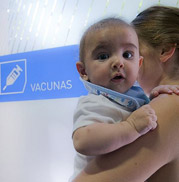
Measles usually causes a high fever, runny nose, a cough, red and watery eyes, and small white spots inside the cheeks. In rare cases severe respiratory or neurological complications may develop. It can be fatal.
A report by the European Centre for Disease Prevention and Control (ECDC) shows 8,127 were reported in the 12 months to March 2013, around 3,600 of which were in Romania with another 2,500 were in UK. (The figures do not capture the full extent of the current epidemic in Wales which peaked around Easter and continues today.)
The worst-affected age group across Europe was infants under one year of age as most of this group had yet to be vaccinated.
As ever, across every age group, the vast majority of infections were seen in those who had not received the MMR vaccine.
Among 1–4-year-olds, which is the age group targeted by routine childhood vaccination programmes, 78% of the cases were in unvaccinated children.
No measles-related deaths were reported during the period but six cases were complicated by acute measles encephalitis.
There were, however, hundreds of cases in every age group and, as seen in the current measles outbreak in the UK, catch-up campaigns may be required to reach adolescents and young adults in countries where immunisation rates were weak in the past. The death of a 25-year-old man in Wales in April has been linked to measles.
Shining examples
Yet there is cause for optimism: several countries – Latvia, Slovenia, Malta, Cyprus, Iceland – have recorded zero cases of measles over the past 12 months; while 14 of the 30 countries reporting data to the ECDC have met the target of less than one measles case per million population.
It seems odd to celebrate thousands of cases of a vaccine-preventable disease but public health experts will be somewhat heartened to see fewer than 10,000 cases in Europe given the severe situation which prevailed just a couple of years ago when there were 37,000 cases in the EU in a single 12-month period.
The trouble is that viruses move across borders so until all European countries wipe out the virus, measles-free status will remain elusive.
Progress on rubella
The picture is a little brighter when it comes to efforts to eliminate rubella. 19 of the 25 countries that reported statistics to the ECDC met the target of less than one case per million population for rubella.
And, just like measles, cases are concentrated in a small number of countries. This time last year, Romania and Poland had been responsible for the vast majority of cases, but in the year to March Romania’s record had improved sharply while a national epidemic has gripped Poland.
The ECDC says that since August 2012, Poland has reported over 95% of all rubella cases, and a total of 9,631 in the past twelve months. The highest notification rate in Poland has been among adolescents aged 15–19 years, suggesting lower levels of immunity.
The outbreak among people in their late teens is a serious concern. While rubella is often a relatively mild illness for most, it can have devastating effects on the foetus if a pregnant woman is infected with the virus.
Babies exposed to the virus in the womb can be born with Congenital Rubella Syndrome (CRS) which disrupts the normal development of some of the baby’s organs. The result can be anything from deafness and cataracts to heart problems and mental retardation.
Countdown 2015
The World Health Organisation is stepping up efforts to monitor elimination efforts ahead of the 2015 deadline, adapting a system previously used to track the elimination of polio in Europe.
Time is tight, but the progress made in just a couple of years offers reason to hope.
Measles elimination: How is your country doing?




